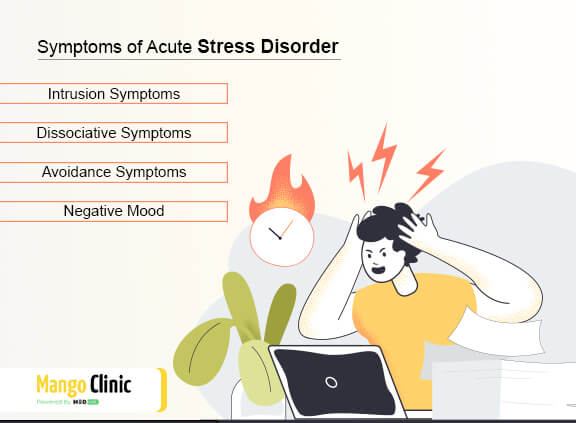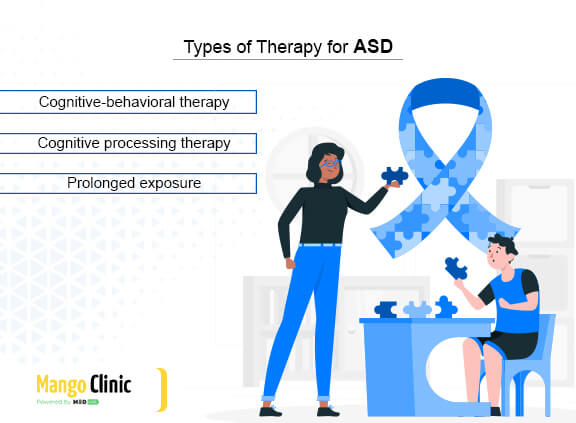Acute Stress Disorder: Symptoms and Treatment

Have you ever experienced severe stress following a tragic event?
Or maybe something traumatizing caused a rapid change in your personality?
If so, you may have had an episode of acute stress disorder (ASD). It is linked to trauma that develops after experiencing a catastrophic incident. Acute stress disorder resembles post-traumatic stress disorder (PTSD) or could be viewed as a condensed form of it. The duration of the symptoms for each of these illnesses varies. Anxiety, dissociation, mood problems, and avoidance of certain situations are the key indicators of ASD.
ASD can result in post-traumatic stress disorder if it is not recognized or treated and causes various psychological symptoms. In this post, we go over the definition of ASD, its symptoms, and its treatment. We’ll also discuss the distinction between post-traumatic stress disorder and acute stress disorder.
To contact the largest network of licensed therapists, click the icon below. We provide a range of therapeutic choices.
What Is Acute Stress Disorder?
ASD is classified as a trauma and stress-related illness in the Diagnostic and Statistical Manual of Mental Disorders, Fifth Edition (DSM-5). People who have directly or indirectly experienced a traumatic or horrifying incident may exhibit unpleasant, strong, and dysfunctional reactions. Acute stress disorder is the term used to describe these responses to severe events.
Direct exposure, for instance, can entail suffering a severe injury, witnessing violence, or being in imminent danger of dying. Indirect exposure can occur when someone witnesses something that is happening to someone else or hears about something that happened to a close friend or family member.
How Long Does Acute Stress Disorder Last?
Approximately a month after a traumatic experience, ASD frequently develops. It lasts for a minimum of three days and a maximum of one month. A PTSD diagnosis may be given if your symptoms last for longer than a month. The events that can be traumatic and result in ASD include:
- Death of someone close or hearing about the death of a close family member or friend
- Posing a high risk of harm to oneself or others
- Threat to one’s own or others’ physical safety
- Experiencing natural or human-made disasters

Symptoms of Acute Stress Disorder
Following a traumatic stressor, ASD symptoms frequently appear right away after the event or shortly after. Clinical distress results from these symptoms in one’s capacity for social, professional, or academic functioning. The initial symptoms appear within four weeks of the traumatic incident and might last for three days to four weeks. Acute stress disorder sufferers may find it difficult to maintain their regular routines because of a sense of detachment or derealization.
A person must have experienced at least nine of the following acute stress symptoms to be diagnosed with ASD.
| Intrusion Symptoms | Dissociative Symptoms |
|
|
| Avoidance Symptoms | Negative Mood |
|
|
Get a professional diagnosis after evaluation of your symptoms. Click the button below!
ASD Vs. PTSD: Difference
After experiencing a startling, terrifying, or deadly event, some persons may develop post-traumatic stress disorder (PTSD). While the majority of traumatized individuals, though not all, have transient symptoms, the majority do not endure persistent (chronic) PTSD. The major symptoms of PTSD appear within 3 months of the traumatic event, although they might also appear years afterward. To be classified as PTSD, symptoms must last for more than a month and be severe enough to interfere with relationships or jobs.
PTSD is an extended and intense form of ASD. Although the signs of the two conditions are somewhat similar, the key distinction is in the timeline. An overview of how ASD and PTSD differ is given below.
| Acute Stress Disorder | Post-traumatic Stress Disorder |
| The symptoms may appear immediately after the incident. | Long-term effects of the traumatic event. |
| Develops and resolves in 30 days following the traumatic event. | PTSD is only diagnosed when symptoms persist over a month. |
| If symptoms persist for more than one month it can turn into PTSD. | Can be a consequence of ASD. |
| A transient disorder appears briefly in a person’s life before disappearing. | Affects an individual’s life, including the spheres like work and relationships. |
Treatment of Acute Stress Disorder
Psychotherapy or medicine may be used to treat ASD, depending on the severity of the symptoms. Psychotherapy aims to address the early symptoms of low intensity, however, medication may be required to treat the more severe symptoms.
Psychotherapy
One of the most popular psychotherapies for patients with acute stress responses is cognitive-behavioral therapy (CBT). It is used when the life of the traumatized person begins to feel more stable, and the person is no longer exposed to the traumatic occurrence. Patients learn how to manage the aftereffects of the traumatic incident and how to avoid the triggers with CBT. Prolonged exposure (PE) and cognitive processing treatment (CPT) are other effective psychotherapy modalities.

Medications
Medications are not the first-line treatment for ASD and they are only used with psychotherapy in severe cases. Typical medications used to treat acute stress disorder are the following:
- Benzodiazepines
- Selective serotonin reuptake inhibitors (SSRIs)
- Hydrocortisone
- Propranolol
Summing Up
Anyone who has experienced trauma struggles to recover. These immediate reactions to distressing events can grow into an acute stress disorder. It, in turn, may lead to issues with friends, at work, and at home and develop into post-traumatic stress disorder if not addressed in a timely manner. However, there are many ASD treatment options that aim to reduce acute stress reaction symptoms and stop them from turning into PTSD. Consider seeing a doctor and getting the right care at Mango Clinic if your stress is persistent or excessive.









